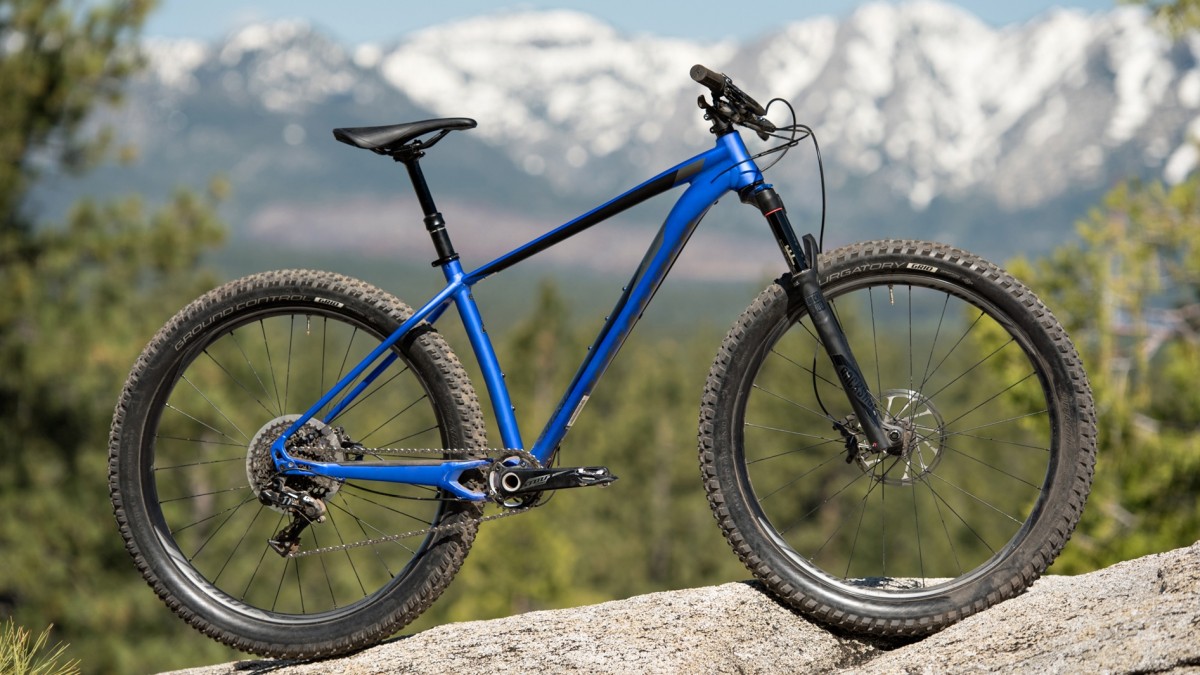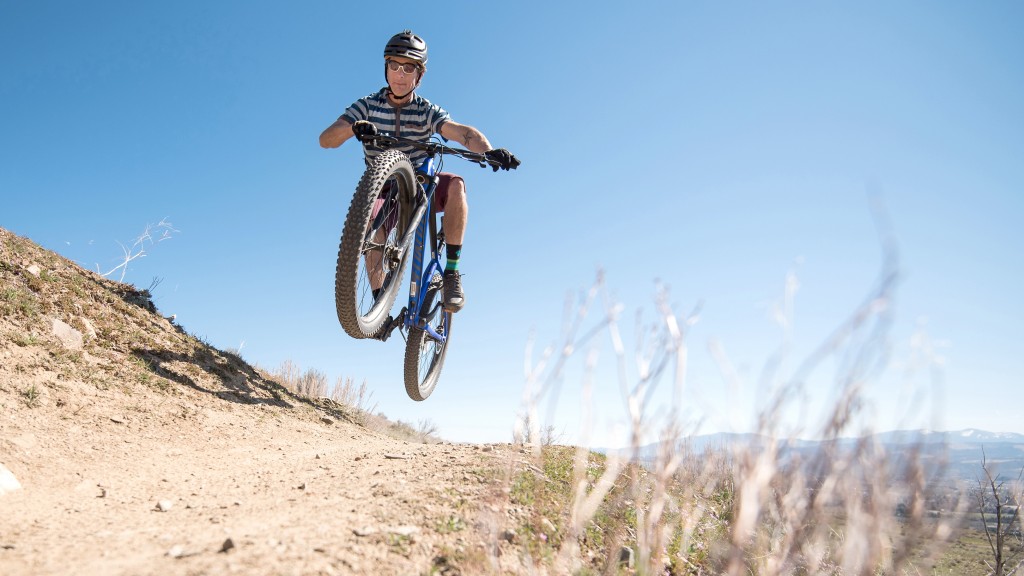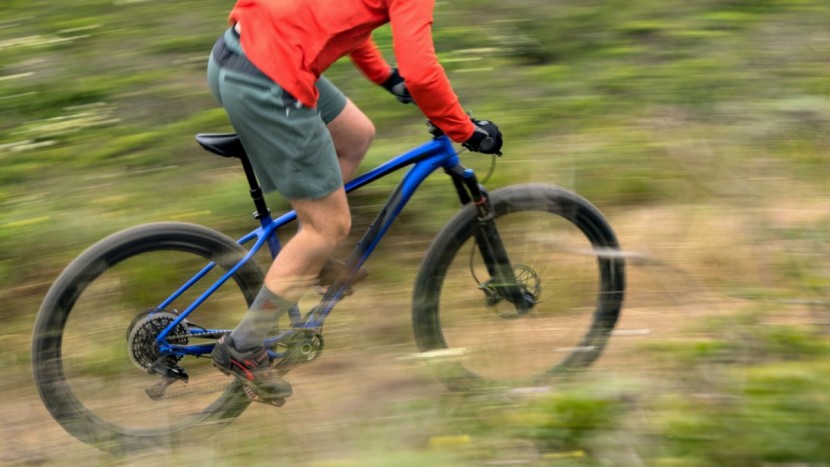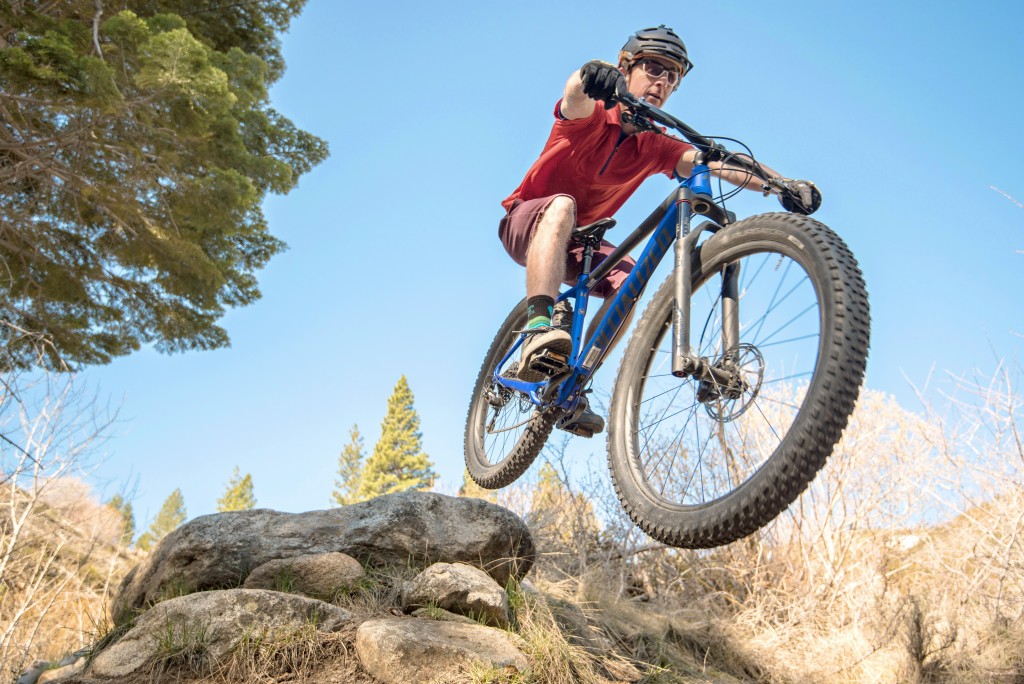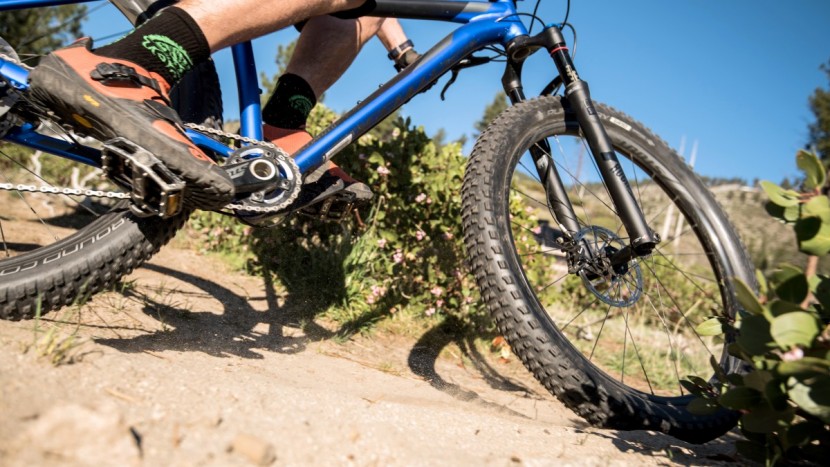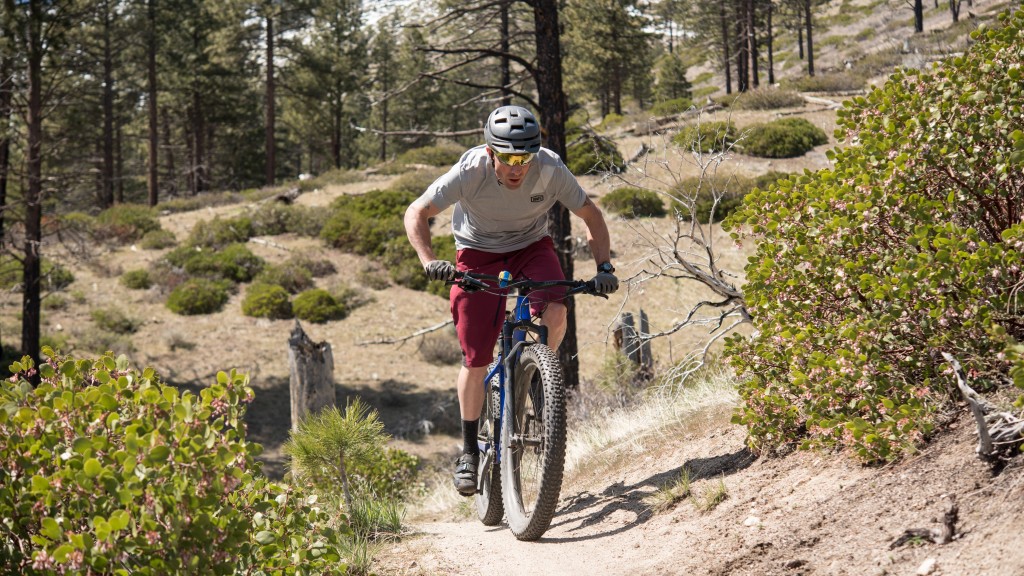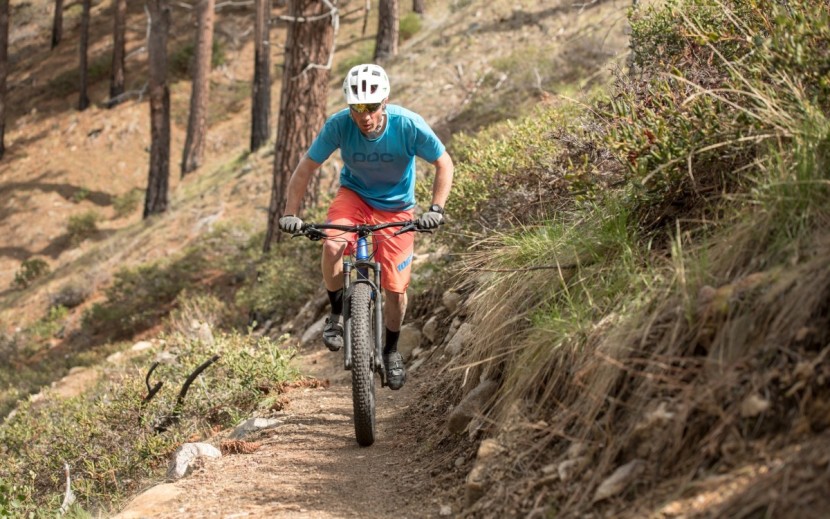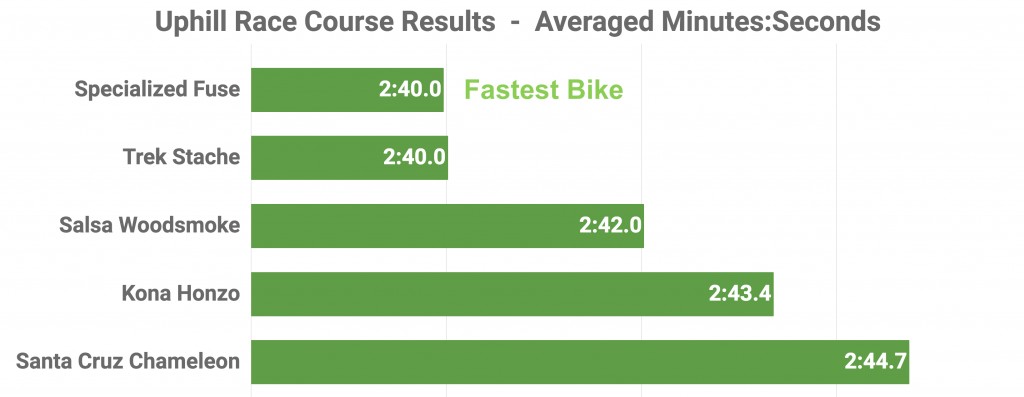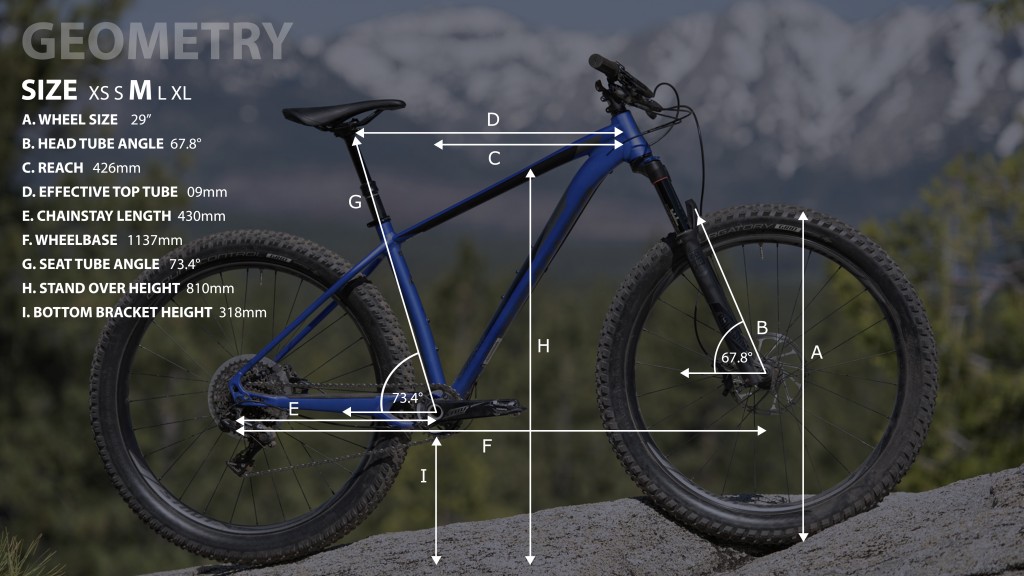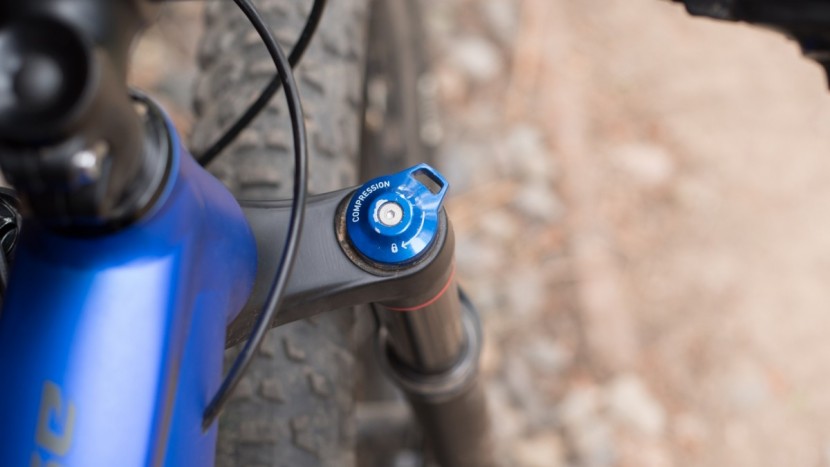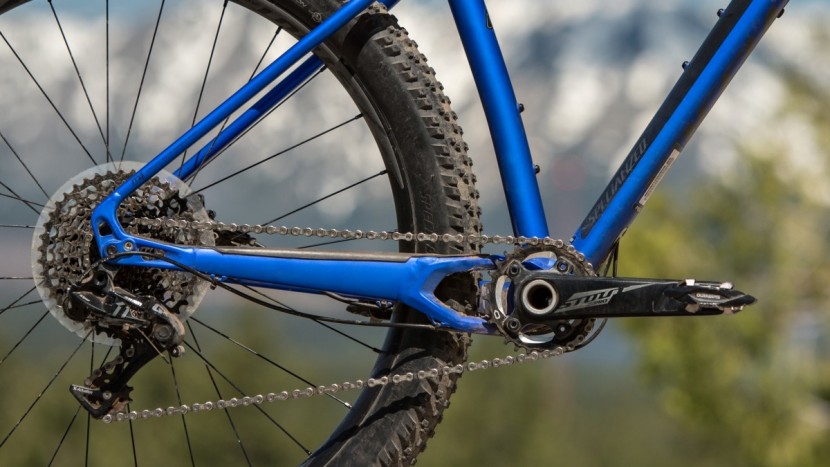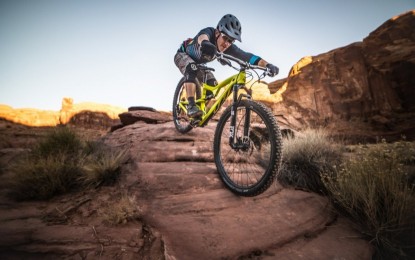Specialized expertly balances climbing and descending performance with the Fuse. Its comfortable geometry expertly distributes its rider's weight over 3-inch wide tires. This results in seemingly endless traction and a surprisingly smooth and stable feel over rough sections of trail. Those trail-cushioning tires pair with precise steering and a play-ready attitude to make the bike a blast when headed downhill. It's also a comfortable and capable climber. The Specialized sports an impressive build kit, including a SRAM GX1 drivetrain and TranzX dropper post. Our primary, yet relatively minor, complaint is that we prefer 2.8-inch tires over the heavier 3-inch tires found on the Fuse. Wider tires produce more rolling resistance and are more sluggish in the corners. The $2,000 price tag is sensible for the bike's balance of performance and value.
The Fuse is the most capable hardtail test bike when it comes to attacking singletrack. Riders seeking a daily driver hardtail will appreciate how it confidently handles technical terrain. Mountain bikers of all abilities can appreciate the simplicity and low ownership costs associated with a hardtail bike. Seeking an ultra-maneuverable play bike? The jovial Santa Cruz Chameleon is a great choice. If multi-hour rides and rough terrain is your style, the efficient, yet capable Santa Cruz Tallboy or ultra-maneuverable and playful Ibis Ripley are excellent alternatives.Specialized Fuse Expert 6Fattie 2017 Review
Our Verdict
Our Analysis and Test Results
2017 Analysis and Test Results
Four OutdoorGearLab testers spent six weeks hammering five hardtails down hundreds of trail miles. We pitted the 2017 Specialized Fuse Expert 6Fattie against the 2017 Santa Cruz Chameleon R1+, Kona Honzo AL/DL, Trek Stache 7 and the Salsa Woodsmoke Carbon 29 NX1. We pushed them to their limits, then ranked them by fun-factor, downhill skills, climbing abilities, cornering characteristics and their build specifications. Then we ran it through again against the 2018 Kona Big Honzo and Devinci Kobain Deore Read all about that comparison in our Best Trail Hardtail Bike review. We also ranked them against all the trail bikes we've tested in our best trail mountain bike review.
Fun Factor
The simplicity and capability of the Specialized Fuse make for an incredibly fun ride. Casual or new riders will enjoy this easy-riding blue beauty and the extreme traction provided by the 27.5 x 3.0" tires. These mid-fat tires can make up for fudged line choices or slightly misappropriated weight distribution. Advanced riders, who might be used to full suspension rigs, will enjoy the nostalgia and challenge of piloting a bike which requires finesse and proper line choice when carrying speed. The Fuse can be slapped around with relative ease and is comfortable launching off trail features.
A quick statement of the obvious: riding down trails is fun. The Fuse doesn't restrict the fun factor. Steering is sharp, although it may be even sharper with slightly narrower tires. The presence of the reliable, and budget-friendly, TranzX dropper post allows riders to drop the saddle low. With the saddle out of the way, riders can get wild. The Fuse is easy to bounce over stumps, logs, and bomb holes. Our testers state that this is the one hardtail in the test that they would pilot down the gnarliest local trail.
If your idea of fun is viciously high speeds, the Specialized is an interesting beast. While it is certainly capable of hitting Mach speeds, you are still on a hardtail with 27.5+ tires. We discuss this phenomenon at greater lengths in the downhill performance section, but high speeds and rough terrain on a 27.5+ hardtail result in a bouncy, un-dampable ride. This isn't exactly fun, in fact, it can get sketchy in a hurry.
We attribute the Fuse's high fun-factor to its all-around pleasant manners on every aspect of the trail. Climbing is efficient, downhill shredding is confidence inspiring, and maneuverability and cornering skills are impressive. The fact that riders are not required to fight any serious negative ride characteristics is a huge bonus, and it is quite rare. Throw an impressive build kit into the equation, and it adds up to a pleasure-filled ride.
Still, the most fun hardtail we've tested only reaches average levels of when compared to the broader capabilities of full suspension trail bikes. It gets a 5 of 10. Riders who are deadset on a jumpy and playful ride will love the Santa Cruz Chamelon. What the Chameleon lacks in traditional trail characteristics, the dirt jump-esque feel is an absolute blast. Riders who value longer days in the saddle should check out the more comfortable Santa Cruz Tallboy.
Downhill Performance
The Fuse is a capable descender that puts riders in an excellent position to succeed. For many, hardtail bikes are associated with the cross country application. However, newer breeds of squishless bikes have substantially more practical and trail-friendly geometry. These bikes focus less on placing your nose over the front axle for speed and focus more on comfort, fun, and confidence. The Fuse is no different. A measured 67.8-degree head angle is confidence inspiring on the downhills and places riders in a semi-aggressive attack position. A 609mm top tube allows sufficient space for riders to move forward or back for proper weight distribution. It goes without saying that the presence of a dropper post is nothing short of magical, and we cannot overstate its value.
The Rock Shox Reba RL fork keeps things under control although testers prefer the Fox Rhythm 34 found on the Santa Cruz Chameleon. The Fuse's longer wheelbase also lends itself to stable descending. The longer running length results in unrivaled steadiness at speed for the category. While the industry puts a lot of deserved emphasis on shorter chainstays these days, there is still a benefit for a longer and properly balanced axle to axle measurement. The 1137mm wheelbase is stable through mixed surfaces, and the steering remains responsive.
Testers are comfortable on a wide variety of trails aboard the Fuse. This trail bike is not perturbed by the rough chop or flow. This blue beauty is unique in that it sets up riders of all abilities to have a blast when aiming downhill. All riders reported a high amount of chain slap aboard the Fuse. This is likely a result of a poor chainline. A larger front chainring would pull the chain up and away from the chainstays. Regardless, wrapping an old tube around the drive-side chainstay would go a long way to eliminating the noise, and add some ghetto points to boot.
It may be obvious, but there is a speed limit on hardtails. Sure, smooth terrain allows for substantial amounts of pinning. That said, encountering chunky sections of trail at speed can be downright jarring. Add some 27.5 x 3.0" tires, and it can be an unpleasantly bouncy endeavor. You can add pedaling traction and the ability to reduce the harsh nature of hardtails by running 16-19 PSI in the tires. Doing so is a serious tradeoff regarding downhill performance. Running a lower tire pressure gives the sensation that you are riding on basketballs. An undeniable bouncing sensation exists when aiming the Fuse over roots and rocks. Running a higher tire pressure, say 21-24 PSI, goes a long way to eliminating this springy sensation, but you begin to lose some of the traction that 27.5+ tires offer, and the ride is significantly harsher.
Our timed downhill benchmark testing reported very tight results. We don't feel comfortable with the bulk of our results, as the lack of consistency does not allow us to draw any reliable conclusions on the relative speeds of all the bikes. What is clear is the Trek Stache was our fastest hardtail bike in the downhill speed trials.
As you might expect, none of the hardtails rank strongly in downhill performance against our full suspension bikes. The best of the rigid rear end bikes, the Fuse still comes in towards the back of the test. It is a surprisingly capable bike on moderately rocky trails, but can't match the composure of a reactive rear suspension.
Climbing Performance
The Specialized Fuse is a sure-footed, capable, climber that has no qualms with technical, smooth or loose ascents. This bike places riders in a comfortable position and rewards rider input with an efficient power transfer.
The Fuse fully benefits from its 27.5 x 3.0" tires when grinding uphill. The large footprint of these tires allows for disgusting levels of traction. On technical pitches, the benefit of these 3.0-inch tires over a normal 2.3-inch trail tire is enormous. Riders who choose to run a lower tire pressure will see an even larger benefit. At 18-20 PSI, 27.5+ tires sag a little bit at the contact point, offering an even greater contact point with the rubber forming to the trail surface. Regardless of which tire pressure you choose, 27.5+ tires provide a sense of drag when compared to normal mountain bike tires. This unavoidable drag may be an exhausting issue for riders who want to pound out all-day rides or participate in a cross-country race.
The longer running length of the Fuse only adds to the splendid traction of this blue beast. According to testers, the long wheelbase does not have a negative effect on uphill handling. Switchbacks are negotiated confidently and do not require too much planning or muscle. Lifting the front end up and over an obstacle is an easy task. The seat tube angle is on the slacker side of the spectrum among our test bikes, measuring to 73.4-degrees. This semi-slack head angle doesn't translate to a noticeably inefficient feel. The 67.8-degree head angle puts the rider in a reasonably forward position to grind up the hills on top of the pedals while maintaining control of the front wheel. The Fuse has a bottom bracket height of 318mm. This isn't particularly high, or low, and pedal strikes are a non-issue.
Testers report feeling a sense of inefficiency or drag with the 3-inch tires on the Specialized. The Santa Cruz Chameleon offers similiar traction with narrower tires. The Chameleon has a less efficient rider position than the Fuse. The Santa Cruz Tallboy is more efficient over rough and variable terrain.
A comfortable and capable climber, the Fuse ranks about average in the wider trail bike test. You would expect hardtails to top the climbing performance rankings among trail bikes. Not so among our more descent focused hardtail selection. The combination of wider tire footprints, slightly more aggressive geometry and the lower-cost, heavier builds we chose to test keep them firmly in mere mortal climbing. This is compounded by the reality that full suspension bikes are getting better and better at isolating pedaling forces from suspension action.
Cornering, Handling, and Body Language
The Fuse handles well without the need for excessive use of force. The middle-of-the-road geometry pays dividends. Slack bikes are thought to be a handful to maneuver at slow speeds, and more upright bikes are assumed to provide skittish handling at speed. Specialized seems to have struck an excellent balance, and while this bike is not the most nimble in the world, it possesses sharp skills. The longer than average wheelbase does not negatively affect handling.
Cornering on 3-inch tires is a somewhat different technique when compared to traditional mountain bike tires. Normal tires typically have an edge that you can feel when leaning into a turn. Feeling this boundary on the tire shoulder is beneficial as going beyond the edge often leads to a painful washout or at least a frightening moment. On 27.5+ tires, the cornering edge is less defined, and riders need to trust the traction of mid-fat tires. It's an act of faith. The TranzX dropper post lets riders get low and dip into the corners sufficiently. The combination of the Specialized Purgatory and Ground Control tires, while not our favorite, is serviceable. The 27.5+ versions of these models feel significantly better than the 27.5-inch or 29-inch iterations. We still recommend slightly narrower rubber. Regardless, the Fuse is impressive in bendy sections of trail even if it doesn't inspire bar drags.
The Fuse hit the scale and came in at 29 lbs 5 ounces. While this is a fair amount of heft, this bike felt noticeably lighter than the others. Moving this bike up and over obstacles does not require Herculean strength. While the Fuse is not playful in the classical sense, the Fuse doesn't object to being hopped over objects and boosting rocks or stumps.
Ease of Maintenance
It is important to pay attention to ease of maintenance when purchasing a bike. Hardtail bikes require considerably less service than full suspension bikes. The lack of a complex suspension design means there are no bearings or links. What the hardtail lacks in performance, it undoubtedly makes up for in simplicity. Still, maintaining the fork, drivetrain, and brakes is still time-consuming and can be costly. Check out our ranking methods in the trail bike review.
This hardtail is at the top of the ease of maintenance chart. Simplicity at its finest. The RockShox fork, however, has a more frequent suggested maintenance interval than Fox alternatives and its SRAM brakes are harder to bleed on than Shimano. We rate it lower as a result.
Frame Design
The Fuse is built with Specialized's butted M4 Aluminum. We measured the head tube angle to 67.8-degrees with the stock 120mm travel fork. This head angle is slacker than a traditional hardtail as the bike is intended to be a trail-style, semi-aggressive ride as opposed to a cross-country bike. The slacker head angle provides stability at speed and places the rider in a more confident and comfortable position on steeper descents. The Fuse has the longest chainstays in our test at 430mm. This big blue beauty has a wheelbase that spans 1137mm. The extra running length adds stability at speed although it can lead to sluggishness and difficulty in corners on some bikes. It's a non-issue for the nimble Fuse.
This bike has clearance for up to 27.5+ x 3.0" tires and can also fit a normal-width 29er tire. Axle spacing is Boost, 12x148mm in the rear and 15x110mm in the front.
Build
If you have been reading carefully, or barely, it should be apparent that we are impressed with the performance of the Fuse. This blazing blue bicycle also wears a very impressive build kit. Components fit the intended application of the bike, and there are few areas that we take issue with.
Fork — Suspension on the front of this bike is provided by a 120mm RockShox Reba RL. This air fork has 32mm stanchions with external rebound and a low-speed compression/lockout knob. While the Reba isn't the smoothest or stiffest performer, it went relatively unnoticed through testing. That is a compliment.
Wheels and Tires — The Fuse rolls on Specialized Stout rims laced to Specialized Stout hubs. These rims have a 38mm inner diameter and provide a good footprint when equipped with 3-inch tires. Hub engagement is fine for a bike of this price point but is far from impressive. It remains to be seen if a 28h front a 24h rear wheelset can withstand the beatdown dished out over years of use on a hardtail, but they are in decent shape following our testing.
The pairing of the Specialized Purgatory 27.5 x 3.0" front tire and the Ground Control 27.5 x 3.0" is solid. We have no major qualms with this setup, and the tires are predictable.
Groupset — The Fuse Expert 6Fattie has a SRAM GX1 drivetrain, one of the nicest in our testing. Shifting remained smooth throughout our test period, and the 28x42-tooth drivetrain provides an excellent gear range for climbing. Riders who ride very high-speed trails might want to consider swapping the 28-tooth ring for a 30-tooth one.
SRAM DB-3 brakes are somewhat of a surprise choice by Specialized. These budget brakes are serviceable, but a bike with a GX1 drivetrain should have at least SRAM Level brakes if not Guides.
Handlebars, Seat and Seatpost — The Fuse is outfitted with a 120mm TranzX dropper which performs reliably throughout testing. The TranzX post costs significantly less than some of the options put out by big names such as RockShox, Thomson, and KS and withstood the beatdown we put on it.
This bike is steered by 750mm wide alloy Specialized bars with a 15mm rise and 31.8mm clamp. We feel wider bars could only help this bike and would also recommend going to a 35.0mm bar while you're at it. The bars connected to the steerer tube by way of a 45mm Specialized stem.
Value
Specialized has a reputation for producing solid, performance bikes at a reasonable price point. The Fuse is no different. The “Big S” produces a smattering of in-house components to keep build costs down. $2000 for a hardtail with a dropper post and GX1 drivetrain is firmly within the realm of reason. Testers unanimously preferred the Fox Rhythm 34 fork found on the Santa Cruz Chameleon. Regardless, it is difficult to complain loudly about the parts specifications on the Fuse given the level of performance it provides.
Suggested Upgrades
While the Fuse is largely ready to rip out of the box, there are a couple of upgrades we suggest. A more aggressive tire would go a long way. Maxxis, OutdoorGearLab's favorite tire manufacturer, now produces a 27.5+ Minion DHF, which would be an excellent front tire and the Maxxis Minion DHR II in the rear would provide a far more aggressive ride. Switching to a 2.8-inch tire width would also save weight and reduce rolling mass while lessening the bouncy effect of plus-sized tires.
In much spendier endeavor, The RockShox Reba RL is an obvious target of a big-dollar upgrade. A RockShox Pike or Fox Float 34 would do wonders front end stiffness and comfort.
Conclusion
The Fuse is a jack of all trades that performs beautifully on all aspects of the trail. While it surely isn't a downhill or cross-country race bike, it can handle whatever you throw at it very well. A 27.5+ hardtail with semi-aggressive angles is a recipe for an efficient and fun ride without fussing with complicated and high-maintenance suspension systems. Whether it is the local flow trail, a cross-country loop, or a big climb to a big descent the Fuse can shred it.


